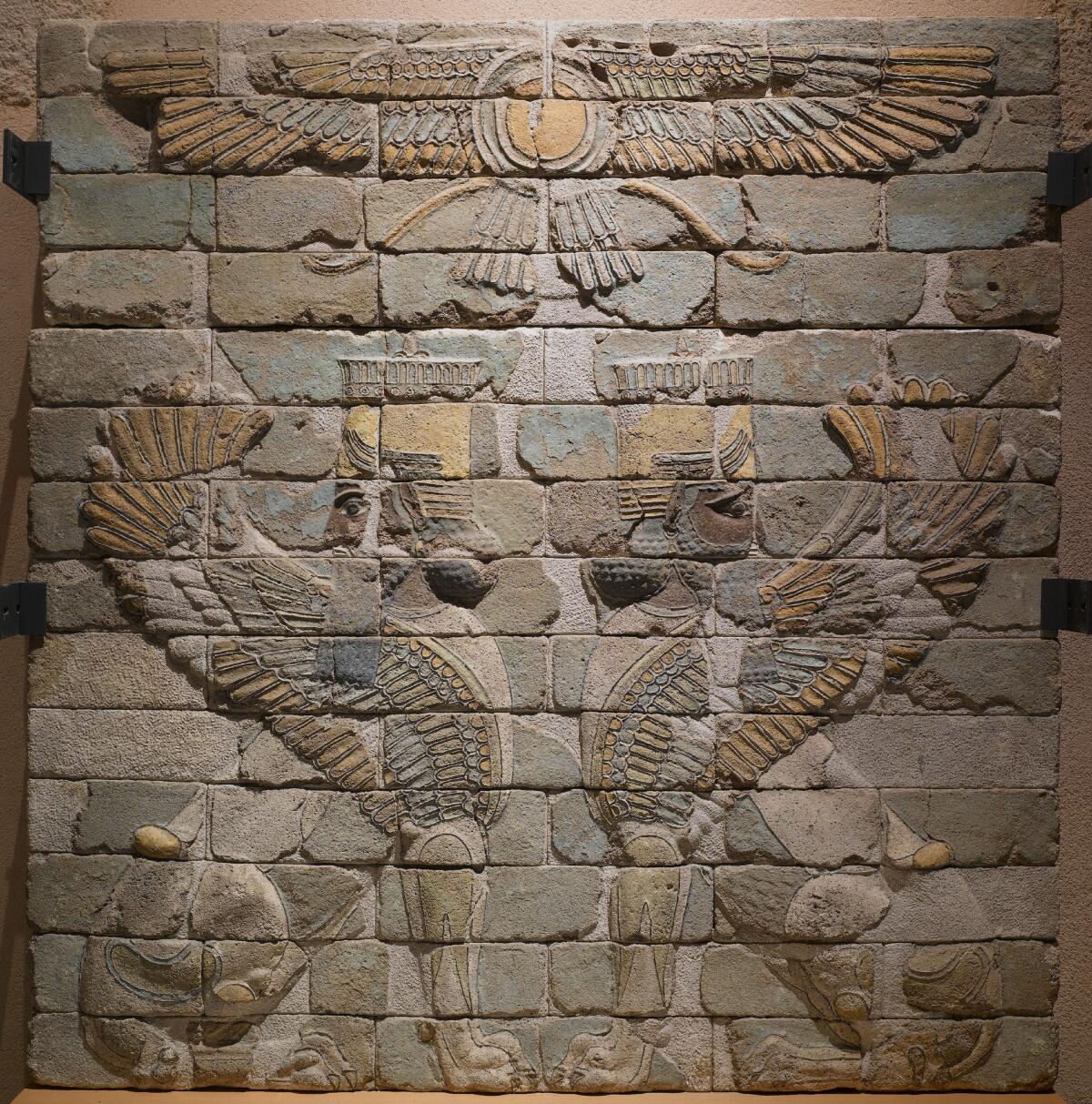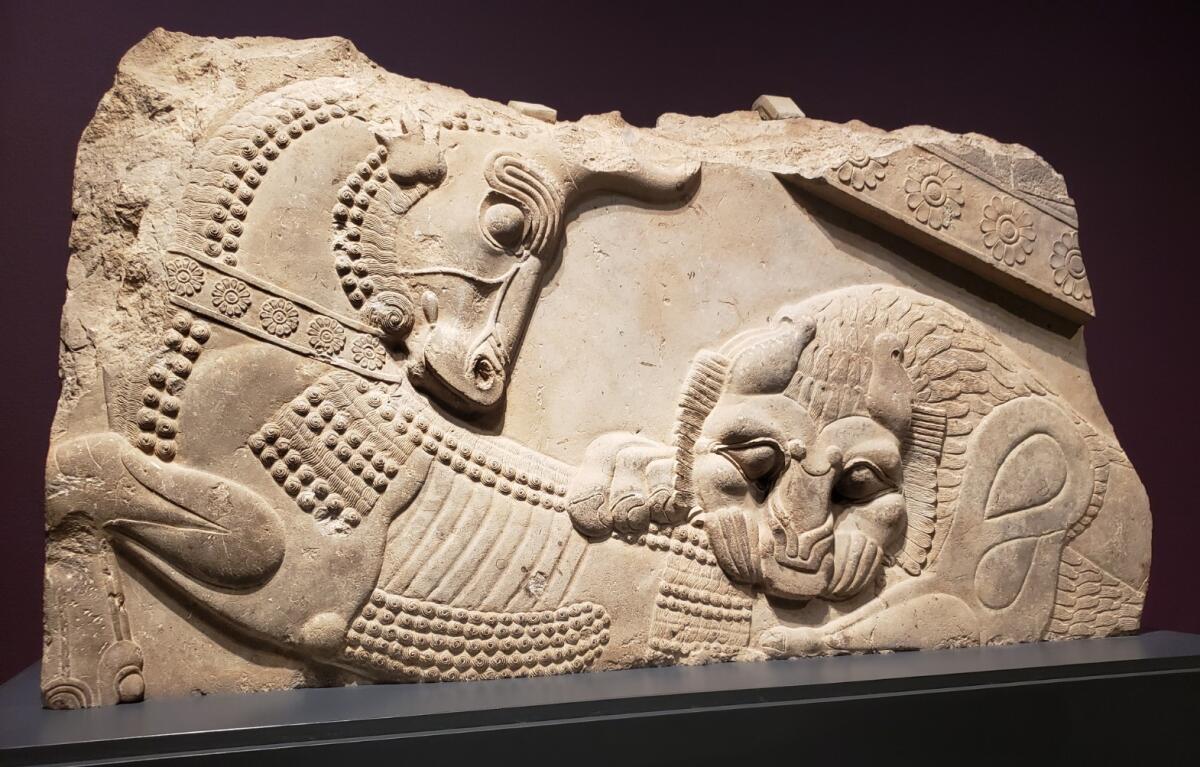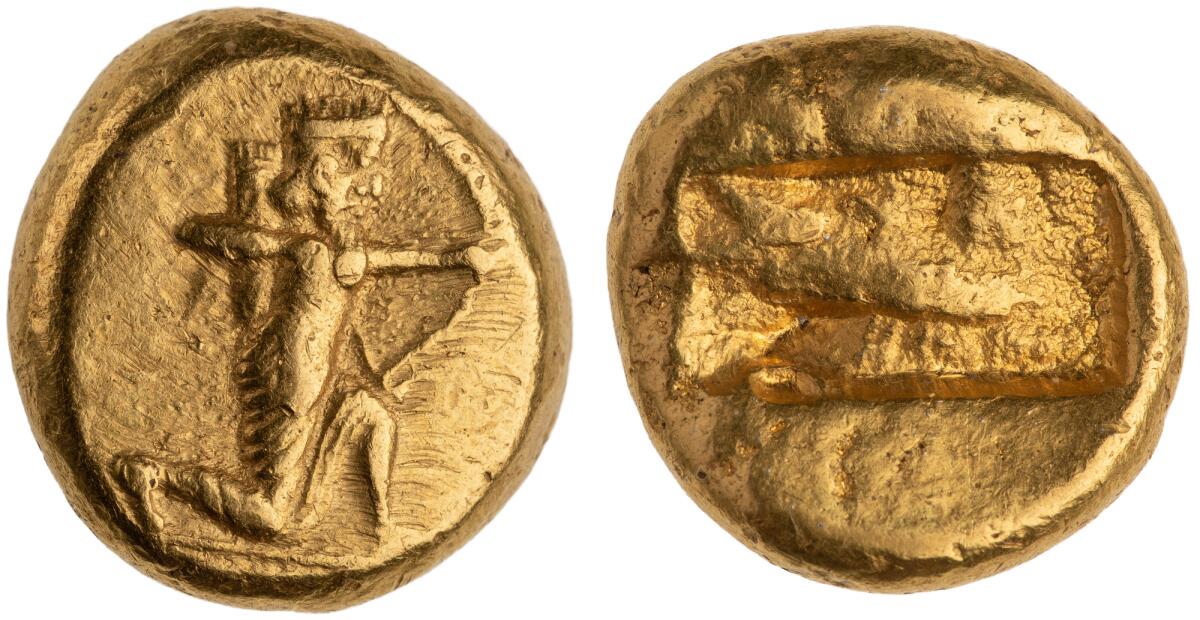Review: A small but strong display of ancient agitprop from Persia comes to the Getty Villa

- Share via
Propaganda is not what it used to be.
These days, a crummy movie like “2000 Mules,” a big cinematic lie about the Big Lie that rampant voter fraud denied the reelection of the last U.S. president, is what passes for artful disinformation. Widely mocked, it’s a lunatic “Triumph of the Will” without the formal skills of Nazi filmmaker Leni Riefenstahl — pollution without the prettiness, Triumph of the Rubes and Grifters.
Oh, for the long-gone days of ancient Persia.
What propaganda used to be is on glamorous display in an exquisitely crafted silver plate that anchors the final room of “Persia: Ancient Iran and the Classical World,” a new exhibition at the Getty Villa in Pacific Palisades. Made in Constantinople around A.D. 629-630, a period when the Eastern Roman power of Byzantium had surprisingly prevailed in a war against Persia’s Sasanian Empire, the nearly 20-inch plate features an elaborate bas-relief that means to help cement the triumph. In three registers, it tells the story of David and Goliath.

David is a stand-in for Heraclius, the relentlessly warring Roman sovereign. Goliath is the bigger, older, more powerful representative of Persia, established for a thousand years. At the top, the two agree to fight as a bemused river god looks on.
In the center, the widest of the three registers, the bout has begun. Goliath has his spear and big shield raised, while David has loaded his slingshot and is waving a distracting cloak in his opponent’s face. How things might go from here is suggested by the soldiers arrayed behind the two combatants: David’s duo stand upright and firm, Goliath’s are turning and lean away, ready to bolt.
In the bottom register comes the dénouement: David hacks off tumbling Goliath’s head, presumably with his own sword. Framing them, the giant’s big pile of scattered weapons at the right dwarfs the winner’s little sling and three small rocks at the left.
The exhibition’s fine catalog, prepared by Getty director Timothy Potts and curators Jeffrey Spier and Sara E. Cole, draws a notable historical conclusion. Heraclius, in his bloody Byzantine victory over Persia, is thought to have beheaded the Sasanian commander. That would make the silver plate a pretty specific allegory for the Eastern Roman emperor as God’s designated champion on earth, like David, the victorious underdog in the struggle against the Philistine giant.
Now, that is some propaganda! Crafted in solid silver, apt for such a valuable image, the large, dramatically designed plate probably was a royal gift made to impress an important dignitary. Heraclius is spreading the word. He puffs up his profile, accentuating his godly kingship and putting his money where his mouth is.
The show is divided into three sections, each focused on a different Persian empire. The Achaemenid (550-330 BC), founded by Cyrus the Great and expanded by Darius I, kicked things off and grew to encompass 2 million square miles — all the way from the Balkans to the Indus Valley. It was the largest empire ever, until Alexander the Great arrived with his armies and busted things up.
The Parthian (247 BC-AD 224) occupied the Silk Route to China, amassing great wealth from trade and cross-fertilizing with Greek civilization. The Sasanian (AD 224-651), arch-rival to voracious Rome, showed remarkable endurance, lasting more than four centuries.
Needless to say, a lot happened in Persia over the course of a thousand years. Too much, in fact, for a small exhibition to fully represent. “Persia: Ancient Iran and the Classical World” is strong on examples of material culture — the pottery, jewelry, coins, metalwork and stone vessels, architecture and other common objects of daily life, mostly among the elite. But, given the museum’s three small rooms, it’s a thumbnail sketch of a thumbnail sketch.

Still, there are wonderful individual objects to see. Impressive loans have come from the Louvre in Paris, the British Museum in London, the Oriental Institute in Chicago and elsewhere. The David and Goliath plate is from New York’s Metropolitan Museum of Art.
Among the works is a fragment of a limestone staircase relief from the ceremonial capital of Persepolis. (Daily, an immersive video about the capital’s main palace is presented on the Getty Villa’s first floor; it also can be viewed at getty.edu/persepolis.) In the piece a lion, shown head-on, has clamped down on the back of a bull, carved in profile. Two powerful natural forces, animals with royal affiliations, are locked in mortal combat.
The dynamism of the relief comes from brilliantly executed visual tensions. An organic, serpentine line describing the forms establishes muscular forward movement, appropriate to a staircase. The competing perpendicular composition of frontal and profile poses is architectonic, like a building’s structure. The repeated modular patterns of animal harnesses and fur emphasize the relief’s ornamental function. Balancing them all is no mean feat, masterfully accomplished by a designer whose name is lost to history.

Lions and bulls were featured on early Achaemenid coins, but a small gold disk announces a shift: A kneeling archer is the figure of Darius I, whose likeness on the chunky little coin asserts his position as the source of ultimate power. The tiny coin is just over a half-inch wide — 8.36 grams of gold, worth about $500 today — and it’s but one of dozens of coins, seals and carved gemstones in the show.
They’re small but fascinating, stylistically changing records of dynasties, rulers, events and timetables of history. Scholars use them to identify all manner of things, like portraits of luminaries and festivals. The Getty has installed touchpads adjacent to each display of groups of them, which lets a viewer examine the object in closeup and access more information.
A wall section of colorfully glazed brick from Darius’ palace features a magnificent pair of sphinxes — seated, unlike their famous Egyptian cousins, who mostly recline. They sport horned crowns signifying deities. Although confronting one another, their contorted male heads turn away a full 180 degrees, as if to underscore their likely role as palace guardians, not opponents.

The Getty also has inserted a work from its own antiquities collection that serves two functions. A highly idealized marble bust of Alexander the Great, carved after his death, is its own bit of romanticized propaganda: It celebrates a powerful human being as impossibly flawless, in order to extend Greek control beyond his incredible lifetime. (The sculpture has undergone minor alteration and seen significant damage over the centuries.) On the other hand, its placement among Persian objects represents the museum’s effort to expand its own institutional focus on the antique art of Greece and Rome.
Ancient Iran joins the pack. “Persia,” apparently the first major museum show of its kind, is one in a series the Getty is presenting. Interactions of Greece and Rome with other Mediterranean cultures — Egypt, Thrace (modern Bulgaria), the Levant (coastal Syria, Lebanon, Jordan and Israel) and the Eurasian steppes — are the subjects of considerable recent research, much of it from the visiting scholars program of the Getty Research Institute. It’s usefully compiled for catalog publication. Unfortunately, what the “Persia” catalog fittingly calls an ancient “clash of cultures” can only be hinted at in an exhibition so modestly scaled.
'Persia: Ancient Iran and the Classical World'
Where: Getty Villa, 17985 Pacific Coast Hwy., Pacific Palisades
When: Wednesdays-Mondays 10 a.m. to 5 p.m., closed Tuesdays. Through Aug. 8.
Info: (310) 440-7300, getty.edu
More to Read
The biggest entertainment stories
Get our big stories about Hollywood, film, television, music, arts, culture and more right in your inbox as soon as they publish.
You may occasionally receive promotional content from the Los Angeles Times.











